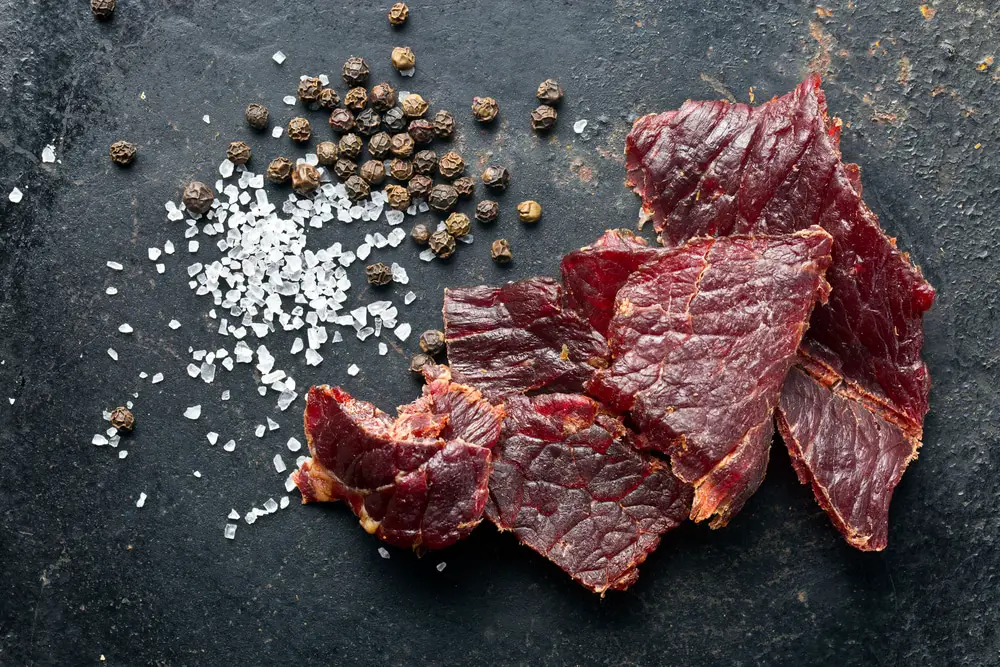Beef jerky is a popular snack loved by many for its savory taste, satisfying texture, and excellent shelf life. Making your own beef jerky at home allows you to customize the flavors to your liking and ensure the quality of the ingredients. Smoking beef jerky adds a layer of complexity and depth to its flavor profile that’s hard to beat. Here’s a detailed guide to creating a delicious beef jerky marinade recipe specifically designed for smoking.
Ingredients:
2 lbs of lean beef (top round, bottom round, or flank steak are great choices)
1/2 cup of soy sauce
1/4 cup of Worcestershire sauce
2 tablespoons of brown sugar
1 tablespoon of liquid smoke (optional, if you want a smokier flavor)
2 teaspoons of black pepper
1 teaspoon of onion powder
1 teaspoon of garlic powder
1/2 teaspoon of red pepper flakes (adjust according to your heat preference)
1/4 teaspoon of curing salt (optional, helps preserve the jerky)
Instructions:
Prepare the Beef: Start by partially freezing the beef to make slicing easier. Aim for slices about 1/8 to 1/4 inch thick. For a more tender jerky, slice against the grain; for a chewier jerky, slice with the grain.
Mix the Marinade: In a large mixing bowl, combine the soy sauce, Worcestershire sauce, brown sugar, liquid smoke (if using), black pepper, onion powder, garlic powder, red pepper flakes, and curing salt. Stir until the sugar and salt are completely dissolved.
Marinate the Beef: Place the beef slices in the marinade, ensuring each piece is well-coated. Cover the bowl with plastic wrap or transfer the contents into a zip-lock bag, and refrigerate for at least 4 hours, preferably overnight. The longer the beef marinates, the more flavorful it will be.
Prep Your Smoker: Preheat your smoker to 165°F (74°C). If your smoker has a water pan, fill it to help maintain moisture during the smoking process.
Drain the Beef: Remove the beef from the marinade and pat dry with paper towels to remove excess liquid. This step is crucial for ensuring the smoke adheres properly to the meat.
Smoke the Beef: Arrange the beef slices on the smoker racks, leaving space between them to allow the smoke to circulate evenly. Smoke the beef for about 4-6 hours. The exact time will depend on the thickness of your slices and how chewy you like your jerky. Begin checking for doneness after 3 hours.
Check for Doneness: The jerky is done when it bends and cracks but does not break. It should have a deep, rich color.
Cool and Store: Allow the jerky to cool completely before storing. Beef jerky can be stored in an airtight container in a cool, dry place for several weeks, or in the refrigerator for a longer shelf life.
Tips for Perfect Smoked Beef Jerky:
Choosing the Right Cut: Lean cuts of beef are best for jerky as fat does not dry out and can cause the jerky to spoil faster.
Marinating Time: For deeper flavor, marinate the beef for up to 24 hours.
Consistent Thickness: Ensure slices are of uniform thickness for even drying and smoking.
Safety First: If using curing salt, follow the package instructions carefully to ensure the jerky is safe to eat.
Making your own smoked beef jerky at home is a rewarding process that not only gives you control over the ingredients and flavors but also provides you with a delicious, high-protein snack that’s perfect for on-the-go activities. Enjoy experimenting with different flavors and smoking woods to create your perfect batch of beef jerky.
Experimenting with Flavors:
One of the joys of making beef jerky at home is the ability to experiment with different flavor profiles. While the recipe provided is a great starting point, don’t hesitate to get creative with your marinades. Consider adding ingredients like maple syrup for a touch of sweetness, apple cider vinegar for tanginess, or smoked paprika for an extra smoky flavor. Herbs like rosemary or thyme can add a fresh, aromatic quality to your jerky. The possibilities are endless, and each batch of jerky can be a new adventure in flavor.
Choosing Smoking Woods:
The type of wood you use for smoking can significantly influence the flavor of your beef jerky. Here are a few popular options:
Hickory: Offers a strong, traditional smoke flavor that pairs well with beef.
Mesquite: Provides a bold, earthy taste but can be overpowering if used in excess.
Apple: Delivers a sweet, mild smoke flavor that complements the savory beef.
Cherry: Similar to apple, cherry wood offers a mildly sweet smoke that can enhance the jerky’s overall flavor profile.
Oak: Known for its medium smoke intensity, oak is versatile and works well for a longer smoking process.
Mixing different woods can create a unique flavor profile, so feel free to experiment with combinations to find your favorite.
Storage Tips:
Proper storage is key to extending the shelf life of your homemade beef jerky. Here are some tips to keep your jerky fresh:
Cool and Dry: Store jerky in a cool, dry place away from direct sunlight. Exposure to heat and moisture can lead to spoilage.
Airtight Containers: Use zip-lock bags or airtight containers to prevent air exposure, which can dry out the jerky further and affect its quality.
Oxygen Absorbers: For long-term storage, consider using oxygen absorbers in your storage containers to help prevent oxidation and spoilage.
Refrigeration: If you’ve made a large batch or plan to keep the jerky for an extended period, refrigerating it can help preserve its freshness.
Enjoying Your Jerky:
Homemade smoked beef jerky is not only a tasty snack but also a great source of protein, making it perfect for hiking trips, long drives, or as a quick energy boost during the day. It’s also a thoughtful, homemade gift for friends and family who appreciate the care and flavor that goes into making it.
By following this guide and experimenting with your own variations, you’ll be able to craft delicious, high-quality beef jerky that surpasses anything you can buy in a store. Enjoy the process and the delicious results!
FAQ: Making Smoked Beef Jerky at Home
What is the best cut of beef for jerky?
The best cuts of beef for jerky are lean cuts with minimal fat, such as top round, bottom round, eye of round, or flank steak. Fat does not dry out and can cause the jerky to spoil faster, so leaner is better.
How thin should I slice the beef?
Beef should be sliced about 1/8 to 1/4 inch thick. This thickness allows the meat to dry out properly without becoming too tough. Slicing the meat while it’s partially frozen can make this process easier and more consistent.
Can I use a dehydrator instead of a smoker?
Yes, you can use a dehydrator to make beef jerky if you don’t have a smoker. The process is similar, but you won’t get the smoky flavor that comes from using wood chips. Add liquid smoke to the marinade if you’re looking for that smoky taste.
How long does homemade beef jerky last?
Properly dried and stored beef jerky can last for several weeks in a cool, dry place. If refrigerated, it can last for several months. Using a vacuum sealer can extend its shelf life even further, up to a year or more.
Is it safe to make beef jerky at home?
Yes, it’s safe to make beef jerky at home as long as you follow food safety guidelines. Using curing salt (such as Prague Powder #1) can help prevent bacterial growth, and ensuring the jerky is dried properly is crucial. Always start with clean equipment and surfaces, and store the jerky properly.
Why is my jerky too tough?
Jerky can become too tough if it’s over-dried, sliced too thin, or made from a particularly tough cut of meat. Ensure your slices are consistent in thickness and monitor the drying process closely to prevent over-drying.
Can I make beef jerky without a smoker or dehydrator?
Yes, you can make beef jerky in a conventional oven by setting it to the lowest temperature, typically around 170°F (77°C). Place the beef strips on a wire rack over a baking sheet to allow air circulation. Keep the oven door slightly open to let moisture escape. This process can take several hours, similar to using a smoker or dehydrator.
How do I know when the jerky is done?
A8: Jerky is done when it is dry to the touch, bends without breaking, and has a leathery appearance. It should not be brittle. The drying time can vary based on slice thickness, humidity, and the drying method used.
Can I make jerky from other types of meat?
Absolutely! While beef is the most common, you can make jerky from turkey, chicken, venison, and even fish. The process is similar, but cooking times may vary. Ensure poultry is cooked to a safe internal temperature before drying.
Can I reuse the marinade?
It’s not recommended to reuse marinade that has been in contact with raw meat due to the risk of bacterial contamination. If you want to use some of the marinade as a sauce, set aside a portion before marinating the meat.
Making your own beef jerky can be a fun and rewarding process, giving you the freedom to tailor flavors to your preference and create a snack that’s healthier and more flavorful than what you can find in stores. Enjoy experimenting with different cuts, marinades, and drying methods to find your perfect jerky recipe.


















